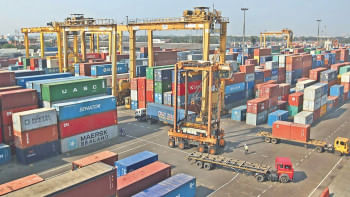Wage gap narrows as inflation eases: BB report

The gap between wages and inflation, which has been narrowing gradually since February 2025, shrank further in the fourth quarter of fiscal year (FY) 2024-25, offering a slight boost to household purchasing power, the central bank said in a report released this week.
In the April-June quarter of FY25, year-on-year headline consumer price index (CPI) inflation averaged 8.9 percent, down from double-digit levels earlier in the year, according to the Bangladesh Bank's "Inflation Dynamics in Bangladesh" report released this week.
During the same period, average wage growth stood at 8.2 percent, indicating a persistent but smaller gap between earnings and prices.
The development points to early signs of recovery in real incomes for millions of low-income consumers in the country, where food and energy costs have surged in recent years. However, according to the Wage Rate Index (WRI) of the Bangladesh Bureau of Statistics (BBS), real wage growth remains negative.
Bangladesh's average wage growth remained negative for the 41st consecutive month in June, even as the inflation rate eased to its lowest level in nearly three years, according to the WRI released earlier this month.
It said year-on-year wage growth stood at 8.18 percent in June, 0.30 percentage points below the month's inflation rate of 8.48 percent.
A similar trend was observed in May, when wages across 63 occupations in the agriculture, industry, and services sectors grew by 8.21 percent, 0.84 percentage points below inflation at the time.
According to the latest BB report, food inflation, which remained in double digits during the first half of FY25, continued to decline in the fourth quarter, falling to 7.4 percent by the end of June.
Cereal products, including rice and wheat, remained the dominant driver of food inflation, contributing an average of 43.7 percent during Q4, the highest quarterly contribution observed in recent periods.
Non-food inflation, however, remained elevated, averaging 9.5 percent in the third and fourth quarters of the fiscal year. Clothing, footwear, and household energy items accounted for the largest share of non-food price increases.
The central bank noted that core inflation, which excludes food and energy, rose 2 percentage points to 49.7 percent of headline inflation in the quarter, suggesting underlying pressures remain strong despite the slowdown in food prices.
Meanwhile, food prices' average contribution to headline inflation declined to 41.3 percent in the fourth quarter from 45.3 percent in the previous quarter. The contribution of energy items, including solid fuels, held steady at around 9 percent in both quarters.
The contribution of perishable goods to overall inflation fell to 30.8 percent from 33.2 percent in the previous quarter, as vegetable and fish prices eased. Non-perishable goods, however, made up a slightly larger share at 50.8 percent, up from 50.0 percent in Q3, the report states.
The services sector's contribution to inflation saw a marginal uptick, rising to 18.4 percent in Q4 from 16.8 percent in the previous quarter.
On a month-on-month basis, inflation rose 0.6 percent in June, reversing a 0.3 percent decline in May. Similarly, m-o-m food inflation increased by 1 percent in June from a 1 percent decline in May. Non-food inflation, however, remained positive at 0.3 percent in both May and June.
The central bank's report comes as multilateral lenders project slower disinflation ahead. The Asian Development Bank (ADB), in its "Asian Development Outlook" published in April 2025, projected Bangladesh's inflation for FY25 at around 10 percent but anticipated a decline in FY26, assuming favourable weather conditions, easing international commodity prices, and stricter domestic policy measures.
The International Monetary Fund (IMF), in its "World Economic Outlook" (WEO) released in April 2025, noted that global headline inflation was likely to decline more slowly than previously expected. However, for low-income and emerging market economies, inflation may fall slightly faster than earlier projections.
The IMF expects Bangladesh's headline inflation to average around 10 percent in 2025 before gradually easing to 5 percent in the following years.

 For all latest news, follow The Daily Star's Google News channel.
For all latest news, follow The Daily Star's Google News channel. 



Comments